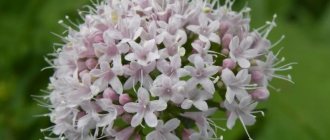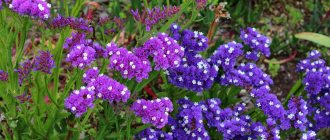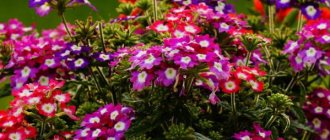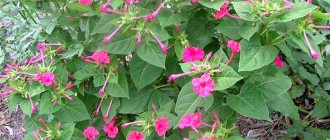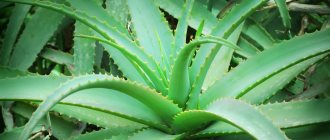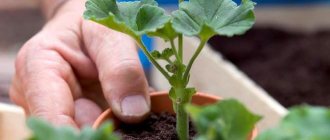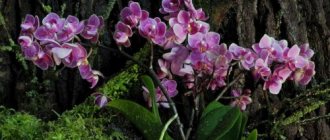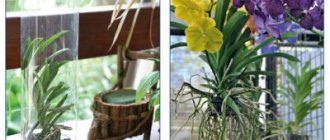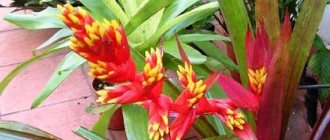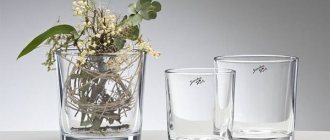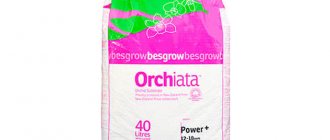Budra ivy grows throughout Russia. It is not found only in some selected arid regions, since this grass does not tolerate high dryness. She prefers:
- deciduous forests;
- nutrient soils in river floodplains.
The leaves retain a green tint even in winter, so it is common not only as a medicine, but also as an ornamental plant. The leaves of the grass themselves are heart-shaped or rounded, with carved edges.
Young shoots, when the time comes, are replaced by old ones. This happens in two seasons - before and after flowering, right up to the first frost. Flowering begins in May and fades by early August.
The fruit is brown, ovoid, up to 2 mm long. Ripens in August. When ripe, the fruits split into 4 parts. The plant has a specific smell, which is why it is popularly called “catnip.”
Budra ivy prefers fertile lands with high humidity
The family to which “catnip” belongs contains slightly less than eight thousand plant species. Clear-leaved herbs include basil, sage, lemon balm, and thyme. But, unlike them, budra is poisonous.
The top part of this herb contains:
- saponins;
- aldehydes;
- triterpinoids;
- bitter substances;
- tartaric acid and acetic acid;
- minerals (potassium, zinc, titanium, molybdenum, manganese);
- carotene;
- vitamin C;
- vitamin-like substance choline;
- amino acids (methionine, cysteine);
- essential oils;
- alkaloids.
Kinds:
- Variegated budra is a perennial creeping plant, favored by many summer residents and gardeners. This type of budra is a living decoration for front gardens and is also used to decorate rocky gardens, tree compositions and flower beds.
- Budra ivy - vegetation reaching 40 cm in height, the root system of which is creeping. Its stem is branched, long, covered in places with short hairs. The flower calyx is tubular, with five teeth. The corolla reaches 20 mm in length, it is two-lipped, bluish-violet. The mouth of the tube has a hairy ring, and the stamens are no longer than the upper lip.
The flowering season begins in April and ends in July. Budra flowers are arranged in up to 6 pcs. in leaf axils.
Useful properties of ivy budra
Only the above-ground elements of budra - leaves, stem and flowers - have healing properties. This medicinal herb is included in certain herbal teas sold in pharmacies.
Budra ivy has:
- anti-inflammatory;
- antiseptic;
- expectorant property.
The active substances contained in this herb have anti-cold, choleretic, healing and anti-sclerotic effects. Improves digestion and appetite.
Decoctions and tinctures based on this plant:
- have an antibacterial effect;
- have antitumor and choleretic properties;
- enhance lactation;
- have a hypotensive effect on the body.
Budra herb is used in therapy, as an addition to medications, relieves symptoms of diseases of the stomach, liver and kidneys, and helps in removing stones from the bladder and kidneys.
Chemical composition
Kitten grass is an aromatic herb. The flowers of the plant are small and have a tubular structure. Their color varies from light lilac to bright purple.
Despite the fact that budra contains toxic substances, the herb still has many beneficial qualities. The upper part of the culture contains saponins, aldehydes, tartaric and acetic acid, carotene, vitamin C, choline, as well as amino acids such as cysteine and methionine, essential oils and alkaloids. In addition, resinous and tannin compounds were found here. The mineral series is represented by such elements as K, Zn, Ti, Mo, Mn and others.
The collection and preparation of medicinal plant materials should be carried out from the beginning of flowering to the beginning of autumn, that is, during the period when the active growth stage is underway. Valuable components are concentrated in the leaves and stems of the plant.
The therapeutic properties of the culture are beyond doubt, but before use, you must first consult with a specialist regarding the possibility of using budra-based formulations and specifying the required doses.
Growing budra: planting and care
Among Russian gardeners, the variegated variety of budra Variegata is common. The leaves have a bluish tint, on which there are clear white spots and sectors, and at times a border is noticeable.
The shoots of this variety spread low along the ground, rising only 7-10 cm. Variaegata blooms extremely rarely, or does not bloom at all.
Among others, another variety of variegated budra, Golden October, stands out. The leaves of this herb, like the wild varieties, are dark green. The surface of the leaf is covered with small golden spots of arbitrary shape.
The grass leaves become most intensely spotted from August to October, when the heat subsides and the weather becomes humid, cloudy and relatively warm.
Budra cannot be called a capricious or selective plant. The main thing to ensure is:
- sufficient amount of light;
- cool room for overwintering grass.
The plant prefers to grow in bright places. But for growing green leaf varieties, a little shade will not be a problem. If the plant is intended to be kept indoors, it is best to place it near southeast or southwest windows.
Outdoors, in open areas, you should choose a piece of land that is well lit by the sun.
In summer, the budra should be taken out into the air, providing slight shading to protect the leaves from being burned by the midday sun.
Catnip feels good at 18-20 oC. During the cold season, the temperature may be slightly lower. In terms of soil, budra is not particularly selective; if it grows in open areas, any soil composition will suit it, provided there is sufficient moisture.
The plant loves bright, diffused light. But for forms with green leaves, slightly shaded areas are also suitable.
If you plan to grow the grass indoors, you should use a mixture of humus, soil and sand as soil.
The plant requires abundant watering from the beginning of flowering until the fruit ripens. Humidification is slightly reduced in the fall, and moderate watering is maintained in winter. In order for the plant to feel good and develop properly, it is necessary to spray its leaves from time to time.
Peculiarities:
- Budra grows vigorously in the spring, after the end of winter rest, so that from April to August it needs monthly feeding once a month. For this purpose, complex fertilizer is used.
- In winter, budra grass needs a long rest. At this time of year, the plant should be moved to a bright room with a temperature of about 5 ° C. Abundant watering is reduced to moderate, and fertilizing should be stopped.
- With the onset of spring, before the budra reaches the stage of active growth, you need to carefully prune the plant to form a neat bush. The shoots remaining after pruning can be used to propagate grass by cuttings. Catnip should only be replanted in the spring and only if necessary - frequent replanting is not good for the grass.
Catnip should only be replanted in spring. Ivy bud is propagated using stem cuttings.
In this case, a cut from the plant is placed in water or wet sand. The cutting will produce roots within a few days. The young plant is moved to a separate pot with prepared soil. The creeping stems of the plant take root well and take root, so if you plant the plant in open ground, it will quickly cover large areas of the ground.
If such growth is not planned, measures must be taken to limit the growth. The variegated variety is more finicky because it requires better lighting and fertile, moist soil saturated with humus.
To ensure the safety of the plant carpet, it is important to prevent drought by constantly adding additional moisture.
The plant can be affected by insect pests if it is not cared for correctly. Budra performs equally well both in indoor gardening and as an element of a lawn, thanks to its ground cover element.
The variegated form can be used in combination with other garden plants to create a beautiful flower arrangement in the garden or cottage. Budra does not harm other garden plants.
Wild varieties of catnip can be used at the base of fruit trees and bushes for turf. Budra covers the soil like a carpet, and thereby delays the evaporation of soil moisture and prevents the development of fungus.
Also, a “carpet” of bud ivy reduces the growth of weeds such as dandelions, since the continuous cover of the soil prevents the unauthorized sowing of their seeds.
Wild budra also feels good in the city, as it tolerates air pollution well. It can be used in city landscaping - for flower beds, courtyard lawns, summer gardens.
As a preventive measure against the spread of the weed, mowing the thickets of the plant is most often used. It should be done before the seeds are thrown out.
Description
Budra ivy is a perennial herbaceous plant of the Lamiaceae family, up to 60 cm long.
The stem is tetrahedral, creeping, rooting, up to 20 cm high. It spreads along the ground and often takes root at the nodes.
The leaves are petiolate, opposite, kidney-shaped or heart-shaped, crenate along the edge, covered with sparse hairs.
Flowering shoots rise upward and bear false whorls of light purple flowers in the leaf axils, with a dark spot on the lower lip. The flowers and stem have a strong unpleasant odor when rubbed.
The flowers are small blue or light purple, two-lipped, irregularly shaped, collected in bunches in the axils of the leaves.
The fruit is dry, breaking into four nuts.
Blooms in April - August. Ripens in June.
Spreading
Budra ivy is common in the European part of Russia, the Caucasus, Kazakhstan and Central Asia. It grows in fields, among bushes, in water meadows, in gardens and orchards. Unpretentious, it can be easily cultivated.
It is often found in fallow fields, along roadsides and near hedges.
Varieties
Variegata
Application of ivy budra
Budra is known for its cleansing properties. It removes ubiquitous toxins and heavy metals from the body. This herb improves metabolism and cleanses blood vessels. In combination with a healthy diet, budra improves well-being and prevents illness.
In medicine
It is used for inflammation, as an antiseptic, expectorant and medicine for better wound healing.
Here are several options for using budra for medical purposes:
- The infusion is prepared as follows: a teaspoon of leaves should be infused in a glass of boiling water. It is recommended to drink warm up to 4 times a day. The tincture helps with colds, asthma, severe runny nose, liver and kidney diseases. It is useful for problems with the gastrointestinal tract and bladder.
- Decoction. In 200 ml of water you need to boil 15 mg of budra, then leave until the broth has cooled. The finished product is used for skin diseases, rashes, suppurations, acne and abscesses, washing the affected areas with it.
- Expectorant collection. You need to take the same amount of cocklebur, hoofed grass and budry herbs. A tablespoon of ready-made dry collection is added to a glass of hot water, then the mixture should be boiled and left for 30 minutes. It is recommended to drink after meals, half a glass 3 times a day.
- Budra with milk. You need to put a small handful of herbs in a liter of fresh milk and boil it. The decoction should be taken warm or hot in the evening before bed. For children, use half a handful of herbs. Budra boiled with milk helps with pulmonary diseases and improves sleep.
- Fresh Juice. Fresh herbs should be crushed in a blender and squeezed out the juice using gauze or linen cloth. Application: adults take 3 tablespoons of juice with water or tea 3 times a day, and children 3 times 1 teaspoon diluted in teal, mulberry, mint or violet tea.
- Powder: from dried leaves: 2 pinches per day, brewed with any tea. The powder strengthens the bronchi and cleanses the lungs of pus and mucus. Valued as a remedy for kidney and gallstones.
- Syrup. Prepare simple sugar syrup, then add the same ratio of fresh herbal juice. Take two tablespoons diluted in tea daily.
- Hot compresses (for pain and cellulite): crushed leaves of the plant are applied directly to the skin, you can also stir them with flaxseed flour before use.
- Wine with the addition of boudra – 1 tbsp. l. herbs for 200 ml of wine. Wine made with catnip helps against parasites, helps normalize the menstrual cycle, and treats jaundice. It also accelerates wound healing and normalizes appetite. This wine is suitable for rinsing the mouth for periodontal disease and washing for abscesses. Preparation: soak the herbs in wine for half an hour and cook until foam appears, then remove from heat and cover with a lid. Can be seasoned with honey.
Budra herb decoction
Budra in cooking
This herb has a slight bitterness, a pleasant aftertaste and a spicy aroma. In a number of European countries, fresh catnip leaves are used as a spice - this improves the absorption of fats in the body, and therefore helps with weight loss.
The plant is also used in salads as a herb. Budra:
- has a beneficial effect on the stomach and intestines;
- improves digestion and microflora;
- promotes healthy appetite.
Budra can be used in an old recipe for making homemade kvass. It consists in the fact that bud leaves are added to flavor the drink, along with mint. Thanks to this, kvass acquires a pleasant bitterness.
This herb has a slight bitterness, a pleasant aftertaste and a spicy aroma.
In folk medicine
In Russia, budra is not recognized as an official medicinal product. However, it has long been known in folk medicine of many nations and is used in different ways. In the past, it was used mostly fresh.
Budra was called “chest grass” because it was often used in the treatment of diseases of the respiratory system, severe wet cough and runny nose.
Dozens of popular names for this herb are known in different countries. For example, Croatians call catnip dobrichica.
Budra is slightly poisonous, so you should follow the recommended dosages for oral use. In some parts of Europe, budra is included in the lists of medicines. It is specially grown in countries where it does not grow wild, as a medicine.
In Russia, flowering shoots are used to make folk medicine. Such drugs are used as an addition to main therapy, used for prevention or as an alternative method of treating diseases. Here are some more ways to prepare the healing remedy:
- For severe bronchial cough, use a tincture: pour a teaspoon of herb into 200 ml (1 cup) of boiling water, wait until the mixture cools. The finished tincture is filtered and taken orally before meals, 1-2 tablespoons.
- For skin diseases and itching - 15 g of budra is poured with 1⁄2 cups of vinegar, then placed in the refrigerator for 7 days. The tincture is used to wipe the affected skin areas once every 3 days.
- A decoction that relieves toothache: 10 mg (two teaspoons) of crushed budra should be poured into 200 mg of water, then simmer over low heat for about 7 minutes. After straining, as a prevention and treatment of periodontal disease, it is used to rinse the mouth, but the decoction should not be swallowed. This remedy helps with sore throat or stomatitis.
- Prevention of runny nose. Decoction from one tbsp. Boil budry in 200 ml of water for about 5 minutes. The finished product is added to the mixture for inhalation. This decoction is good for diseases of the respiratory system.
- To treat skin diseases or inflammatory diseases of the joints, the crushed herb is diluted with a small amount of boiling water and stirred to form a paste. When warm, it is wrapped in gauze and used in compresses. The bandage needs to be changed 3-4 times a day. It is recommended to take baths with budra tincture for fractures - this will speed up the healing process.
- To relieve pain from abscesses, apply a paste of fresh budra leaves to them; this will also speed up healing. The tincture can be used for enemas for hemorrhoids, but only in small quantities.
origin of name
The word "Glechoma" comes from the Greek word "glechon", which means mint or thyme. "Hederaceae" is Latin for "ivy-like", which most likely refers to the shape of the leaves or their resemblance to weeds.
Budra was first named Glechoma hederacea by Carl Linnaeus (1741 – 1778) in his book Species Plantarum, published in 1753. But in 1843, the German botanist George Bentham (1800 – 1884) reclassified this species as Nepeta glechoma in his monumental work on the Labiatae, Labiatarum Genera et Species.
The word "Nepeta" translated means "ivy from Nepete", which is probably named after the Etruscan city of Nepeta.
In 1842, the Italian botanist Vittore Benedetto Antonio Trevisan (1818 – 1897) described the same species as Nepeta hederacea. However, all these names soon became simple synonyms.
Today, most botanists agree with Linnaeus's original name Glechoma hederacea, although the alternative name Nepeta hederacea is still used occasionally.
Overdose
Use budra for self-medication with caution. It is very important to observe the dosage, since in large quantities the herb causes poisoning, and symptoms may include:
- weak pulse;
- heat;
- hard breath;
- bleeding.
Intoxication in case of overdose causes severe sweating, salivation and tachycardia. Breathing problems may occur.
If this happens, you should call an ambulance and take calcium chloride, activated carbon or a laxative. This is why it is important to carefully observe the dose of ivy bud.
Popular variety in landscape design
Many summer residents, having discovered catnip on their property, try to remove it. But a variety of glechoma has been developed, which is highly decorative and fast growing. During the season, you can create a beautiful living carpet on your site if you plant ivy-shaped budra Variegata.
Features of Variegata:
- The leaves are decorated with specks, iridescent silver;
- The length of creeping shoots is 30-70 cm and the height of flower stems is 10-15 cm;
- Flowering begins in May, in the fall the leaves turn pinkish-green and so go into winter;
- To preserve its decorative appearance, it needs to be illuminated by the rays of the sun for 3-4 hours. In partial shade, the foliage becomes pale green and silvery inclusions are almost invisible.
Planted in hanging pots and used as a ground cover crop.
How to propagate?
In nature, grass conquers territories very easily. Roots are formed in the leaf internodes, which take root upon contact with the soil. This can be used in spring and summer for reproduction. For example, place a container with soil near an adult bush and pin the shoot for rooting. After 4-5 weeks, you can separate the shoot and grow the seedling as an independent bush.
When describing ivy budra, we noted that its shoots are vegetative and flowering. Therefore, experts recommend choosing vegetative stems for cuttings.
Propagation by cuttings
Cuttings cut in spring and summer can be easily rooted both in water and in moist soil.
Rooting in water:
- Cuttings of 7-10 cm, which have 2-3 internodes, are cut, the leaves are removed;
- The branches are immersed 1 cm deep in a container with water. It is advisable to shade the container from the sun, because in the dark the roots will appear faster;
- The water must be changed every 3 days, adding crushed activated carbon to it (1 tablet per 200 ml of water);
- After 5 days, the first small roots will appear. When their length reaches 2 cm, the cuttings can be planted in the ground.
If you use a substrate for rooting cuttings, then first select a container with a lid. The soil is used well moist and loose. After planting the cuttings, the container is covered with a lid or film to create greenhouse conditions. The place for rooting is chosen dark and warm. Periodically open the cuttings, remove condensation from the lid and moisten the soil.
When leaves appear at the leaf nodes, rooting has been successful. The shelter is removed and the cuttings are replanted along with a lump of earth.
Growing from seeds
Planting ivy budra in a flower bed or in a corner in the garden can also be done with seeds.
You can sow seeds in early spring and autumn. The emerging seedlings have good winter hardiness and will easily tolerate frost.
Planting catnip with seeds:
- the area must be loosened;
- remove all weeds;
- moisten the soil;
- sow seeds in any order on the soil surface;
- sprinkle with a thin layer of soil, compacting it slightly;
- Until the seedlings appear, the beds are watered 2 times a week.
And then the bushes will grow.
